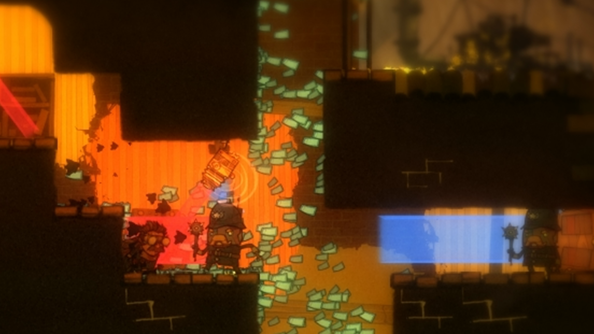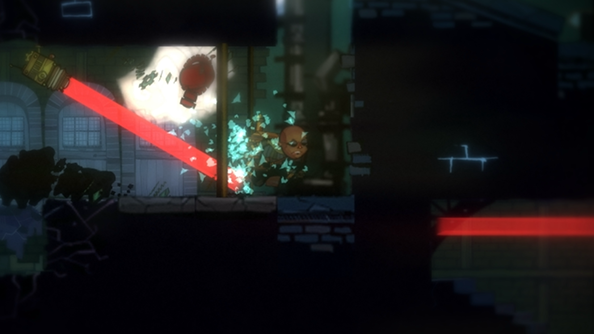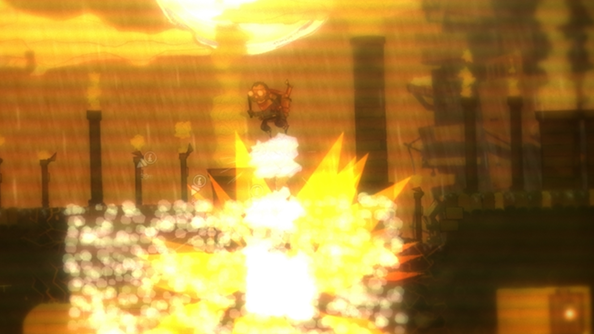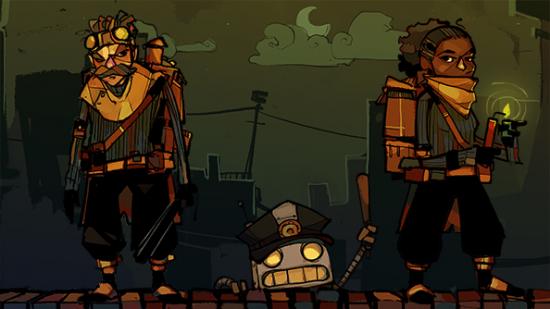Having deannounced it a while back, Size Five Games have just reannounced The Swindle. It’s a sort of side-scrolling Deus Ex in which you break into heavily guarded buildings, hack money out of computers, swipe bags of cash from vaults and then run away.
The old Swindle didn’t really work, admits developer Dan Marshall, but this Swindle does. It’s been overhauled, refurbished, gutted and rebuilt into something that’s infinitely more compelling and fun to play: a smart, steampunk roguelike, a stealth RPG with permadeath and procedurally generated levels and scoops of Victorian charm and character.
I’ve been playing it and, well, it’s remarkable. It’s Spelunky in a top hat.
In The Swindle you play the role of a master thief, operating a team of professional pilferers from your blimp high above the city. These thieves are all randomly generated, each with a unique look and name, and each can be upgraded with abilities and tools, earning XP and racking up experience as you perform successful heists. If they die or get caught however, they’re gone for good, forcing you to start over with a fresh tea-leaf.
The levels you’re infiltrating are all generated on the fly, so no two are the same. Generally (at least in the shanty town area of the game that I played — there are five distinct districts planned, each with different levels of security) there’ll be a number of different ways to enter the target building: smashing through windows, slipping in through doors, or by noisily blowing holes in walls.

By avoiding detection you can sneak about the rooms and corridors, accessing computer terminals to drain them of their cash. The goal is to empty the building of as much loot as possible before returning to your escape pod, but guards diligently patrol areas of the level, with just enough predictability in their behaviour to allow you to outwit or outmanoeuvre them.
You can clobber them from behind, or use some of the more advanced and unlockable gymnastic abilities to stay out of the way of their bright yellow cones of vision, double jumping and wall jumping to get behind them. Mines can be used to trap and kill guards, and turrets can be hacked and used as temporary allies.

The armoury of tools has already grown since I played, from explosives and mines and temporary invisibility to EMP blasts and teleportation devices. The game’s steampunk setting gives it free rein to go as sci-fi as it likes with its toys and gadgets. There are also money-sapping bugs that can be attached to computers in levels to generate a constant trickle of income until they’re discovered or destroyed, a simple addition that immediately grants the game world a degree of persistence and economy.
Stumbling into the path of a guard or flouncing into the vision radius of a camera will trigger alarms across the level and cause a number of things to happen. For a start, there’s no returning to stealth tactics once guards have been alerted to your presence: The Swindle goes from a game about sneaking to a game about evasion and escape. Being caught isn’t a fail state.

The money available in terminals slowly begins to dwindle (presumably as the account holders slowly withdraw their cash from the compromised building? It’s probably not worth thinking about too hard), so the rewards for sticking around become fewer and fewer. Similarly, the remaining cash littered about the floor becomes exponentially more difficult to get to, so your best bet is to exfiltrate with whatever amount you’ve managed to grab.
It’s like running out of time in the Crystal Maze. Here however, instead of Richard O’Brien locking you in a room with a massive Rubik’s cube, sticking around fortoo long means the police will show up and attempt to beat you to death. These coppers will pursue you more aggressively than the regular guards, and should their attempts to thwart you fail, you’ll eventually be faced with The Swindle’s very own Baron von Blubba, its Hurry Up Monster, a bulldozing helicopter thing piloted by a particularly destructive policeman.

When I played, the immediate compulsion was to clean out levels in perfect runs, clobbering only those who needed clobbering in order to grab every last penny in the building. But being caught, even though it shuts down the possibility of hoovering up 100% of the loot, transforms The Swindle into an action game, opening up the possibility of using some of the louder tools and abilities you’d tend to keep in your pocket while being stealthy.
That switch-up between the stealth and action gears meant that, at least in the time I had with the game, there was no moment of frustration to be found in The Swindle’s gameplay loop, no point at which you feel it’s appropriate to quit and go do something else. Like Spelunky, death was often unexpected but never inexplicable. You die because you stop paying attention to your surroundings long enough to trip into a spike trap, stumble into a landmine or fall down in front of a guard.
It’s also really pretty, with random weather effects and tiny visual details that you’ll love. The sight of your little thief scooting along a rooftop, silhouetted against the moon and utterly silent apart from the rhythmic clacking of his boots on the Victorian slate is immediately striking. When you die, all of the cash you’ve grabbed sort of explodes in a big cloud of banknotes too, like Sonic The Hedgehog but in a more practical currency.
Size Five’s Dan Marshall is still tweaking the repercussions of death in The Swindle, figuring out whether certain abilities and tools should be handed down to the next generation of thief, or whether every new life means a blank slate and a fresh start. I trust him to make it feel right. He’s the sort of person who throws away entire games if they don’t feel right.
The Swindle is set to release sometime in early 2015. You can find out more about it by following @danthat on Twitter.
